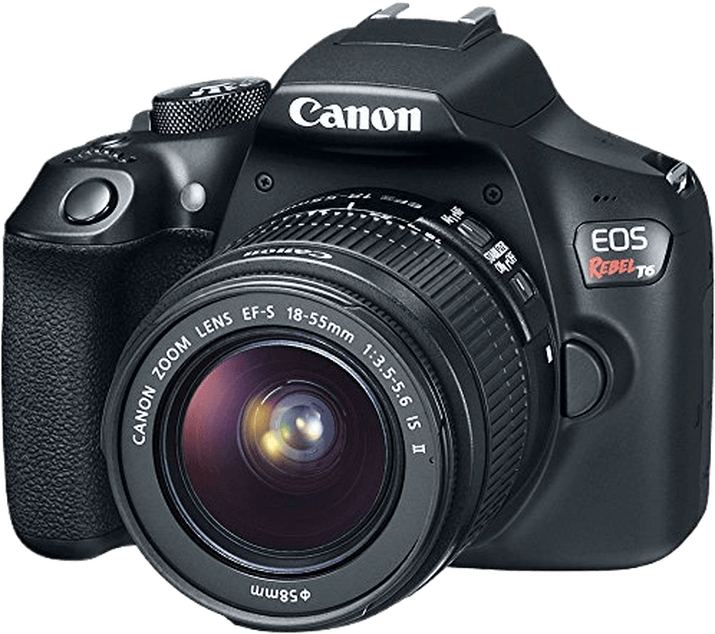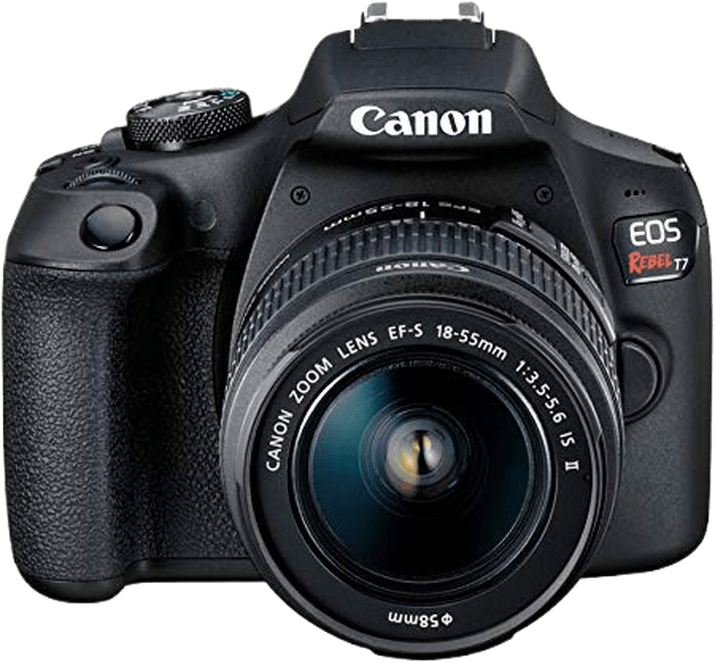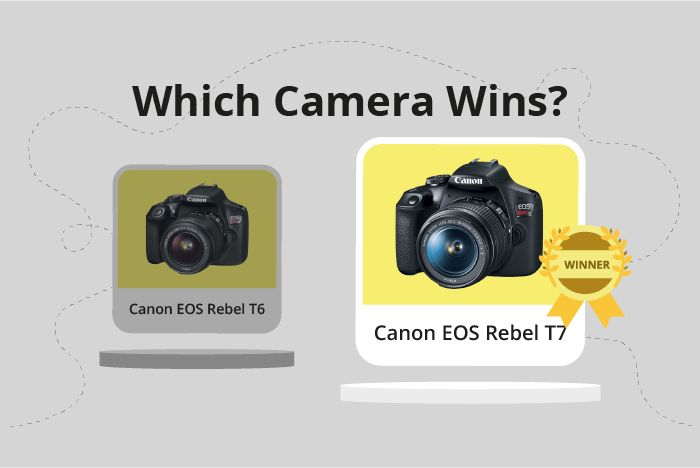Canon EOS Rebel T6 / 1300D vs EOS Rebel T7 / 2000D Comparison
Canon EOS Rebel T6 / 1300D

Canon EOS Rebel T7 / 2000D

The Canon EOS Rebel T7 / 2000D emerges as the winner with a score of 50/100, while the Canon EOS Rebel T6 / 1300D trails behind with a score of 39/100. Both cameras are DSLRs with the same launch price of $550 and identical dimensions of 129 x 101 x 78mm. They were released two years apart, with the T6 / 1300D in 2016 and the T7 / 2000D in 2018.
The T7 / 2000D outperforms the T6 / 1300D due to its higher score, which indicates its superior features and performance. However, the T6 / 1300D has an advantage in terms of weight, being lighter at 485g / 1.07lbs compared to the T7 / 2000D’s 660g / 1.46lbs.
Based on these specifications, the Canon EOS Rebel T7 / 2000D is a better camera, but the EOS Rebel T6 / 1300D may be more suitable for those prioritizing a lighter device.
Canon EOS Rebel T6 / 1300D vs EOS Rebel T7 / 2000D Overview and Optics
The Canon EOS Rebel T7 / 2000D outperforms the Canon EOS Rebel T6 / 1300D in optics, with a score of 56/100 compared to 40/100. Both cameras share several specifications, including a shooting speed of 3, a CMOS sensor type, a Digic 4+ processor, an APS-C sensor size, a Canon EF-S lens mount, and no image stabilization.
The T7 / 2000D excels with its 24.1 megapixels, providing higher resolution images than the T6 / 1300D’s 18 megapixels. This difference allows the T7 / 2000D to capture more detail in photographs. Additionally, the T7 / 2000D has a higher DXOMARK score for its sensor, 71, compared to the T6 / 1300D’s score of 66. This higher score translates to better overall image quality and low-light performance for the T7 / 2000D.
The T6 / 1300D does not have any specific advantages over the T7 / 2000D in terms of optics. Both cameras share the same shooting speed, sensor type, processor, sensor size, lens mount, and lack of image stabilization. Thus, the T6 / 1300D does not outshine the T7 / 2000D in any optical aspects.
Based on the comparison of their optical specifications, the Canon EOS Rebel T7 / 2000D is the superior camera. Its higher megapixel count and DXOMARK sensor score contribute to better image quality and low-light performance. The Canon EOS Rebel T6 / 1300D, while sharing some common features with the T7 / 2000D, does not offer any advantages in the realm of optics.
Canon EOS Rebel T6 / 1300D vs EOS Rebel T7 / 2000D Video Performance
The Canon EOS Rebel T6 (1300D) and the Canon EOS Rebel T7 (2000D) both have a video score of 43/100, indicating that their video capabilities are very similar. In terms of common specifications, both cameras offer Full HD video resolution with maximum dimensions of 1920 x 1080 pixels and a maximum video frame rate of 30fps. Additionally, neither camera has built-in time-lapse functionality.
Despite the equal video scores, there might be some differences between the two cameras that could make one more suitable for specific situations. However, based on the provided specifications, both the Canon EOS Rebel T6 and the Canon EOS Rebel T7 have the same video capabilities, making it difficult to determine a clear winner in this category.
Since both cameras have the same video score and similar specifications, it is not possible to identify any advantages for either camera in terms of video capabilities. Users can expect comparable video performance from both the Canon EOS Rebel T6 and the Canon EOS Rebel T7.
Given the equal video scores and shared specifications, potential buyers can focus on other factors when choosing between these two cameras. Factors such as price, additional features, and personal preferences can help determine the best option for each individual.
Canon EOS Rebel T6 / 1300D vs EOS Rebel T7 / 2000D Features and Benefits
The Canon EOS Rebel T6 / 1300D and the Canon EOS Rebel T7 / 2000D both have a feature score of 41/100, making them equal in this category. They share several specifications, including a 3-inch screen size, 920000-dot screen resolution, flip screen, and the absence of a touchscreen. Neither camera has GPS, but both have WIFI capabilities. Additionally, neither camera has Bluetooth.
Since both cameras have the same feature score, it is essential to examine the specific features that make each camera better than the other. However, in this case, both cameras have identical specifications, making it difficult to determine which camera is better based on features alone.
Despite having the same feature score and specifications, there may be other factors that make one camera better than the other, such as price, availability, or user preference. It is essential to consider these factors when choosing between the Canon EOS Rebel T6 / 1300D and the Canon EOS Rebel T7 / 2000D.
Given that both cameras have identical feature scores and specifications, it is challenging to determine a clear winner based on features alone. It is crucial for potential buyers to consider other factors, such as price, availability, and personal preference, when deciding between the Canon EOS Rebel T6 / 1300D and the Canon EOS Rebel T7 / 2000D.
Canon EOS Rebel T6 / 1300D vs EOS Rebel T7 / 2000D Storage and Battery
The Canon EOS Rebel T6 and the Canon EOS Rebel T7 have identical storage and battery scores of 27/100. Both cameras have one memory card slot and accept SD, SDHC, and SDXC memory cards. They each have a battery life of 500 shots and use the LP-E10 battery type. Neither camera has USB charging capabilities.
Despite their identical scores, there are no significant differences between the two cameras in terms of storage and battery. Both cameras provide users with the same level of performance and convenience in these aspects.
In conclusion, the storage and battery specifications of the Canon EOS Rebel T6 and the Canon EOS Rebel T7 are the same, making them equal in this category. Buyers can confidently choose either camera without sacrificing storage or battery performance.
Alternatives to the Canon EOS Rebel T6 / 1300D and EOS Rebel T7 / 2000D
Are you still undecided about which camera is right for you? Have a look at these popular comparisons that feature the Canon EOS Rebel T6 / 1300D or the Canon EOS Rebel T7 / 2000D:

